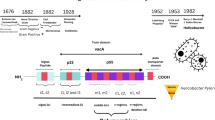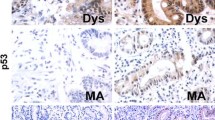Abstract
Background. Despite the fact that the association of Helicobacter pylori with an increased risk of gastric cancer has been well documented, the exact mechanisms of this association have not been fully elucidated. Scarce data on H. pylori infection and its relationship with the different pathological characteristics are available in Egypt.
Aim of the Study. The rationale of the present study was to determine the prevalence of H. pylori in a group of gastric cancer patients and to analyze the relationship between H. pylori infection with the different pathological characteristics including the types of gastric cancer and tumor location within the stomach, in addition, to investigate the Bcl-2 and Bax expressions along with DNA flow cytometric analysis in the gastric cancer patients with and without H. pylori infection.
Methods. Samples were obtained from 66 consecutive patients with gastric cancer (46 males and 20 females). The youngest patient was 20 yr old, the oldest 76 yr with mean age of 52.8 yr. The samples were subjected for histopathological characterization, H. pylori detection, DNA flow cytometric analysis, and Bcl-2 and Bax expressions detection, in addition to apoptosis analysis.
Results. The obtained results showed that the H. pylori infection was found in 38/66 (57.6%) [Odds ratio=1.357 with 95% confidence interval (CI) 0.84–2.2]. There was a statistical significance for Bcl-2, Bax, and apoptosis with H. pylori status (p=0.009, 0.008, 0.032, respectively). On the other hand, There was a statistical significance for H. pylori infection with the disease grade (p=0.015) and lymph node metastasis (p=0.05). No statistical significance was found between H. pylori status with the patients’ age, gender, tumor site, tumor type, depth of invasion, and stromal reaction.
Conclusions. These data may indicate that the H. pylori infection not only contributes in the disease formation through the apoptosis dysregulation but also takes a part in the disease dissemination and progression. In addition, it may reflect a biologic, pathogenic, and ethnic background affecting the relationship of H. pylori infection to gastric cancer in the Egyptian patients. A high rate of smoking in Egypt and the diet are important factors that may affect such background. Further studies are warranted.
Similar content being viewed by others
References
Kusters JG. Recent developments in Helicobacter pylori vaccination. Gastroenterol 2001;234(Suppl):15–21.
Nilsson I, Utt M, Nilsson HO, Ljungh A, Wadstrom T. Two-dimensional electrophoretic and immunoblot analysis of cell surface proteins of spiral-shaped and coccoid forms of Helicobacter pylori. Electrophoresis 2000;21:2670–2677.
Wen M, Zhang Y, Yamada N, Matsuhisa T, Matsukura N, Sugisaki Y. An evaluative system for the response of antibacterial therapy based on the morphological change of Helicobacter pylori and mucosal inflammation. Pathol Int 1999;49:332–337.
Khin MM, Ringner M, Aleljung P, Wadstrom T, Ho B. Binding of human plasminogen and lactoferrin by Helicobacter pylori coccoid forms. J Med Microbiol 1996;45:433–439.
She FF, Su DH, Lin JY, Zhou LY. Virulence and potential pathogenicity of coccoid Helicobacter pylori induced by antibiotics. World J Gastroenterol 2001;7:254–258.
Brenner H, Bode G, Adler G, Hoffmeister A, Koenig W, Rothenbacher D. Alcohol as a gastric disinfectant? The complex relationship between alcohol consumption and current Helicobacter pylori infection. Epidemiology 2001;12:209–214.
Guarner J, Mohar A, Parsonnet J, Halperin D. The association between Helicobacter pylori and gastric neoplasia. Epidemiologic evidence. Rev Gastroenterol Mex 2000;65:20–24.
Schistosomes, liver flukes and Helicobacter pylori. IARC working Group on the Evaluation of Carcinogenic Risks to Humans. Lyon, 7–14 June 1994. IARC Monogr Eval Carcinog Risks Hum 1994;61:1–241.
Shirin H, Sordillo EM, Oh SH, et al. Helicobacter pylori inhibits the G1 to S transition in AGS gastric epithelial cells. Cancer Res 1999;59:2277–2281.
Yang Y, Deng CS, Peng JZ, Wong BC-Y, Lam SK, Xia HH-X. Effect of Helicobacter pylori on apoptosis and apoptosis related genes in gastric cancer cells. J Clin Pathol Mol Pathol 2003;56:19–24.
Konturek PC, Konturek SJ, Pierzchalski P, et al. Cancerogenesis in Helicobacter pylori infected stomach—role of growth factors, apoptosis and cyclooxygenases (Review Article). Med Sci Monit 2001;7(5):1092–1107.
Koturek PC, Koturek SJ, Sulekova Z, et al. Expression of hepatocytes growth factor, transforming growth factor alpha, apoptosis related proteins Bax and Bcl-2 and gastrin in human gastric cancer. Aliment PharmacolTher 2001;15:989–999.
Krajewska M, Fengalia-Preisner CM, Krajewski E, et al. Immunohistochemical analysis of Bcl-2 family proteins in adenocarcinomas of the stomach. Am J Pathol 1996;149:1449–1457.
Lowe SW, Lin AW. Apoptosis in cancer. Carcinogenesis 2000;21:485–495
Sarraf CE, Bowen ID. Proportions of mitotic and apoptotic cells in a range of untreated experimental tumors. Cell Tissue Kinet 1988;21:45–49.
Leoncini L, Delvecchio MT, Megha T, et al. Correlations between apoptotic and proliferatives indices in malignant non-Hodgkin’s lymphomas. Am J Pathol 1993;142:755–763.
Shangary S, Johnson DE. Peptides derived from BH3 domains of Bcl-2 family members: a comparative analysis of inhibition of Bcl-2, Bcl-x(L) and Bax oligomerization, induction of cytochrome c release, and activation of cell death. Biochemistry 2002;41:9485–9495.
Zhang H, Fang D-C, Wang R-Q, Yang S-M, Liu H-F, Luo Y-H. Effect of Helicobacter pylori infection on expressions of Bcl-2 family members in gastric adenocarcinoma. World J Gastroenterol 2004;10(2):227–230.
Sasaki O, Soejima K, Haraguchi Y. Intra-tumor DNA ploidy distribution pattern and its relation to histologic type in gastric carcinoma. Path Res Pract 1992;188:545–549.
Tomoda H, Inoue T. Flow cytometric analysis of the DNA content in primary and metastatic lesions of colorectal cancer. J Surg Oncol 1995;59:101–104.
Wang LS, Wu LH, Chang CJ, Fahn WY, Huang MH, Chiu JH. Flow-cytometric DNA content analysis of oesophageal carcinoma. Comparison between tumor and sequential nontumor mucosae. Scand. Cardiovasc J 1998;32(4)205–212.
Adachi Y, Mori M, Haraguchi M, Sugimachi K, Tsuneyoshi M. Cytophotometric study of nuclear DNA content in scrirhous gastric carcinoma. Pathology 1995;27:5–7.
Rugge M, Sonego F, Panozzo M, et al. Pathology and ploidy in the prognosis of gastric cancer with no extranodal metastasis. Cancer 1994;73:1127–1133.
Sakusabe M, Kodana M, Sato Y, Kikuchi T, Koyama K. Clinical significance of DNA ploidy pattern in stage III gastric cancer. World J Surg 1996;20:27–31.
Brito MJ, Filipe MI, Thompson H, Ormerod MG, Titley J. DNA ploidy in early gastric carcinoma (T+): A flow cytometric study of 100 European cases. Gut 1993;34:230–234.
Fujimaki E, Nakano O, Chiba S, et al. DNA ploidy heterogeneity in early and advanced gastric cancers. Cytometry (Communication in Clinical Cytometry) 1996;26:131–136.
Imada T, Yamamoto Y, Fukuzawa K, et al. Flow cytometric analysis of nuclear DNA heterogeneity in gastric cancer. Jpn J Clin Oncol 1997;7(4):221–226.
Osterheld MC, Laurini R, Saraga E, Bosman FT. Evaluation of heterogeneity of DNA ploidy in early gastric cancers. Analyt Cell Pathol 1999;19:67–72.
Lee WJ, Lin JT, Shun CT, et al. Comparison between resectable gastric adenocarcinomas seropositive and seronegative for Helicobacter pylori. Br J Surg 1995;82(6):802–805.
Abdel-Wahab M, Attallah AM, Elshal MF, et al. Cellular proliferation and ploidy of the gastric mucosa: the role of Helicobacter pylori. Hepatogastroenterology 1997;44(15):880–885.
Clarkson KS, West KP. Gastric cancer and Helicobacter pylori infection. J Clin Pathol 1993;46(11):997–999.
Feldman RA, Eccersley AJ, Hardie JM. Epidemiology of Helicobacter pylori: acquisition, transmission, population prevalence and disease-to-infection ratio. Br Med Bull 1998;54:39–53.
Dooley CP, Cohen H, Fitzgibbons PL, et al. Prevalence of Helicobacter pylori infection and histologic gastritis in asymptomatic persons. N Engl J Med 1989;321:1562–1566.
Asaka M, Kimura T, Kudo M, et al. Relationship of Helicobacter pylori to serum pepsinogens in an asymptomatic Japanese population. Gastroenterol 1992;102:760–766.
Youn HS, Ko GH, Chung MH, Lee WK, Cho MJ, Rhee KH. Pathogenesis and prevention of stomach cancer. J Kor Med Sci 1996;11:373–385.
Sipponen P, Marshall BJ. Gastritis and gastric cancer, Western countries. Gastroenterol Clin North Am 2000;29:579–592.
Plummer M, Franceschi S, Munoz N. Epidemiology of gastric cancer. IARC Sci Publ 2004;157:311–326
Lee I, Lee H, Kim M, et al. Ethnic difference of Helicobacter pylori gastritis: Korean and Japanese gastritis is characterized by male- and antrum-predominant acute foveolitis in comparison with American gastritis. World J Gastroenterol 2005;11(1):94–98.
Imper V, van Wart HE. Substrate Specificity and Mechanisms of Substrate Recognition of the Matrix Metalloproteases. Academic Press, CA, 1998.
Wielockx B, Libert C, Wilson C. Matrilysin (matrix metalloproteinase-7): a new promising drug target in cancer and inflammation? Cytokine Growth Factor Rev 2004;15:111–115.
Yanagisawa N, Geironson L, Abu Al-Soud W, Ljungh A. Expression of matrix metalloprotease-2, -7 and -9 on human colon, liver and bile duct cell lines by enteric and gastric Helicobacter species. FEMS Immunol Med Microbiol 2005;44(2):197–204.
Kato T, Saito Y, Niwa M, et al. Helicobacter pylori infection in gastric carcinoma. Eur J Gastroenterol Hepatol 1994;Suppl 1:S93–96.
Kim HY, Cho BD, Chang WK, et al. Helicobacter pylori infection and the risk of gastric cancer among the Korean population. J Gastroenterol Hepatol 1997;12(2):100–103.
Author information
Authors and Affiliations
Corresponding authors
Rights and permissions
About this article
Cite this article
El-Shahat, M., El-Masry, S., Lotfy, M. et al. Relationship of Helicobacter pylori to Bcl-2 family expression, DNA content, and pathological characteristics of gastric cancer. Int J Gastrointest Canc 36, 61–68 (2005). https://doi.org/10.1385/IJGC:36:2:61
Issue Date:
DOI: https://doi.org/10.1385/IJGC:36:2:61




